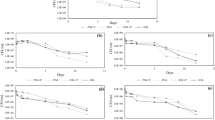Abstract
Malolactic fermentation (MLF) plays an important role in the production of wine, especially red wines, resulting in microbial stability, deacidification, as well as contributing to the aroma profile. MLF can be influenced by a number of factors. In this study, the influence of pH and ethanol on expression of the structural malolactic enzyme gene (mle) from Lactobacillus plantarum was investigated in a synthetic wine media, as well as in wine using quantitative PCR. Expression of mle was shown to be inducible by the presence of malic acid, with increased expression in the middle of MLF. Expression of mle was also shown to be increased at low pH values and decreased in the presence of ethanol. This indicates the role of MLF in acid tolerance and the negative impact of ethanol on the completion of MLF. The results therefore provide further evidence that L. plantarum should be applied as co-inoculation for MLF where alcohol will initially not have a negative impact on the malic acid degradation.








Similar content being viewed by others
References
Arthurs CE, Lloyd D (1999) Kinetics, stereospecificity, and expression of the malolactic enzyme. Appl Environ Microbiol 65:3360–3363
Bartowsky EJ (2005) Oenococcus oeni and malolactic fermentation—moving into the molecular arena. Aust J Grape Wine Res 11:174–187
Beltramo C, Desroche N, Tourdot-Maréchal R et al (2006) Real-time PCR for characterizing the stress response of Oenococcus oeni in a wine-like medium. Res Microbiol 157:267–274
Björkroth J, Korkeala H (1996) Evaluation of Lactobacillus sake contamination in vacuum-packaged sliced cooked meat products by ribotyping. J Food Prot 59:398–401
du Toit M, Engelbrecht L, Lerm E, Krieger-Weber S (2010) Lactobacillus: the next generation of malolactic fermentation starter cultures—an overview. Food Bioprocess Technol. doi:10.1007/s11947-010-0448-8
Gockawiak H, Henschke PA (2003) Interaction of pH, ethanol concentration and wine matrix on induction of malolactic fermentation with commercial ‘direct inoculation’ starter cultures. Aust J Grape Wine Res 9:200–209
Henick-Kling T (1993) Malolactic fermentation. In: Fleet GH (ed) Wine microbiology and biotechnology. Harwood Academic Publishers, Chur, Switzerland, pp 289–326
Hoffman CS, Winston F (1987) A ten-minute DNA preparation from yeast efficiently releases autonomous plasmids for transformation of Escherichia coli. Gene 57:267–272
Jussier D, Morneau AD, Mira de Ordũna R (2006) Effect of simultaneous inoculation with yeast and bacteria on fermentation kinetics and key wine parameters of cool-climate Chardonnay. Appl Environ Microbiol 72:221–227
Konings WN (2002) The cell membrane and the struggle for life of lactic acid bacteria. Antonie van Leeuwenhoek 82:3–27
Kunkee RE (1991) Some roles of malic acid in the malolactic fermentation in wine making. FEMS Microbiol Lett 88:55–72
Labarre C, Divies C, Guzzo J (1996) Genetic organization of the mle locus and identification of a mleR-like gene from Leuconostoc oenos. Appl Environ Microbiol 62:4493–4498
Labarre C, Guzzo J, Cavin JF et al (1996) Cloning and characterization of the genes encoding the malolactic enzyme and the malate permease of Leuconostoc oenos. Appl Environ Microbiol 62:1274–1282
Lemme A, Sztajer H, Wagner-Döber I (2010) Characterization of mleR, a positive regulator of malolactic fermentation and part of the acid tolerance response in Streptococcus mutans. BMC Microbiol 10:280–1471
Lerm E, Engelbrecht L, du Toit M (2010) Malolactic fermentation: the ABC’s of MLF. S Afr J Enol Vitic 31:186–212
Liu SQ (2002) Malolactic fermentation in wine—beyond deacidification. J Appl Microbiol 92:589–601
Livak KJ, Schmittgen TD (2001) Analysis of relative gene expression data using real-time quantitative PCR and the 2−ΔΔCT method. Methods 25:402–408
Lonvaud-Funel A (1995) Microbiology of the malolactic fermentation: molecular aspects. FEMS Microbiol Lett 126:209–214
Lonvaud-Funel A (1999) Lactic acid bacteria in the quality improvement and depreciation of wine. Antonie van Leeuwenhoek 76:317–331
Nel HA, Bauer R, Vandamme EJ et al (2001) Growth optimization of Pediococcus damnosus NCFB 1832 and the influence of pH and nutrients on the production of pediocin PD-1. J Appl Microbiol 91:1131–1138
Pitcher DG, Saunders NA, Owen RJ (1989) Rapid extraction of bacterial genomic DNA with guanidium thiocyanate. Lett Appl Microbiol 8:151–156
Rojo-Bezares B, Saenz Y, Navarro L et al (2007) Coculture-inducible bacteriocin activity of Lactobacillus plantarum strain J23 isolated from grape must. Food Microbiol 24:482–491
Ugliano M, Genovese A, Moio L (2003) Hydrolysis of wine aroma precursors during malolactic fermentation with four commercial starter cultures of Oenococcus oeni. J Agric Food Chem 51:5073–5078
Vaillant H, Formisyn P, Gerbaux V (1995) Malolactic fermentation of wine: study of the influence of some physiochemical factors by experimental design assays. J Appl Bacteriol 79:640–650
Zapparoli G, Tosi E, Azzolini et al (2009) Bacterial inoculation strategies for the achievement of malolactic fermentation in high-alcohol wines. S Afr J Enol Vitic 30:49–55
Acknowledgments
The authors gratefully acknowledge the financial support of Lallemand Inc., Winetech, NRF and THRIP, as well as the German Federal Ministry of Education and Research for sponsoring a research stay of Bronwen Miller at the MRI in Karlsruhe.
Author information
Authors and Affiliations
Corresponding author
Rights and permissions
About this article
Cite this article
Miller, B.J., Franz, C.M.A.P., Cho, GS. et al. Expression of the Malolactic Enzyme Gene (mle) from Lactobacillus plantarum Under Winemaking Conditions. Curr Microbiol 62, 1682–1688 (2011). https://doi.org/10.1007/s00284-011-9914-4
Received:
Accepted:
Published:
Issue Date:
DOI: https://doi.org/10.1007/s00284-011-9914-4




